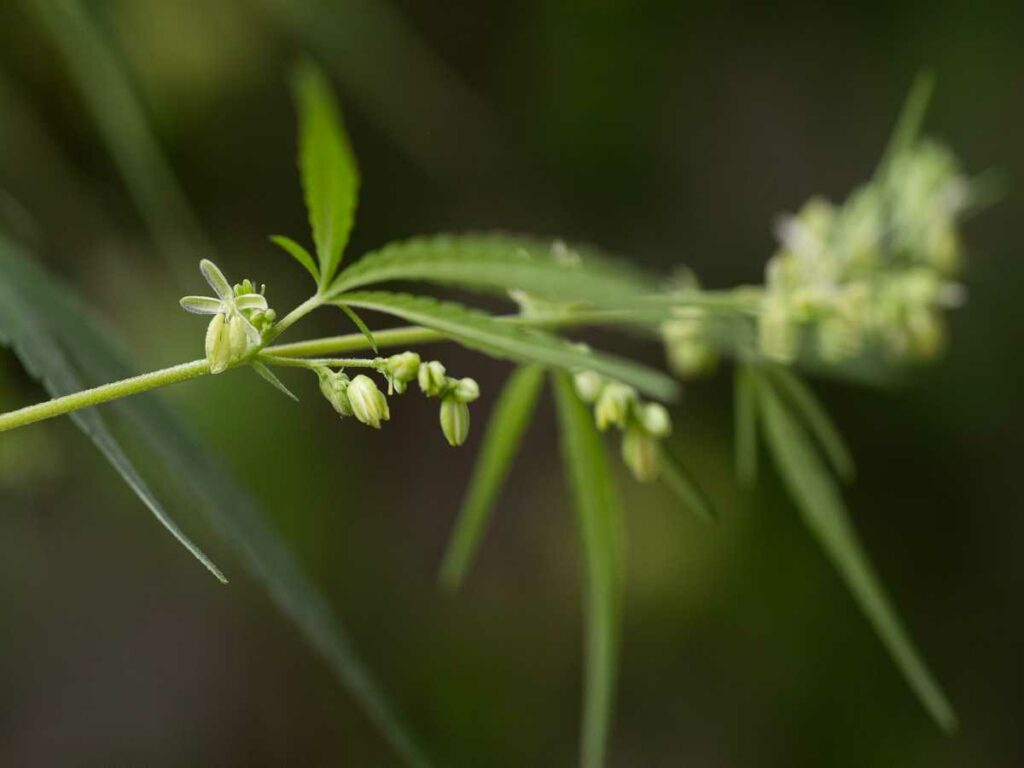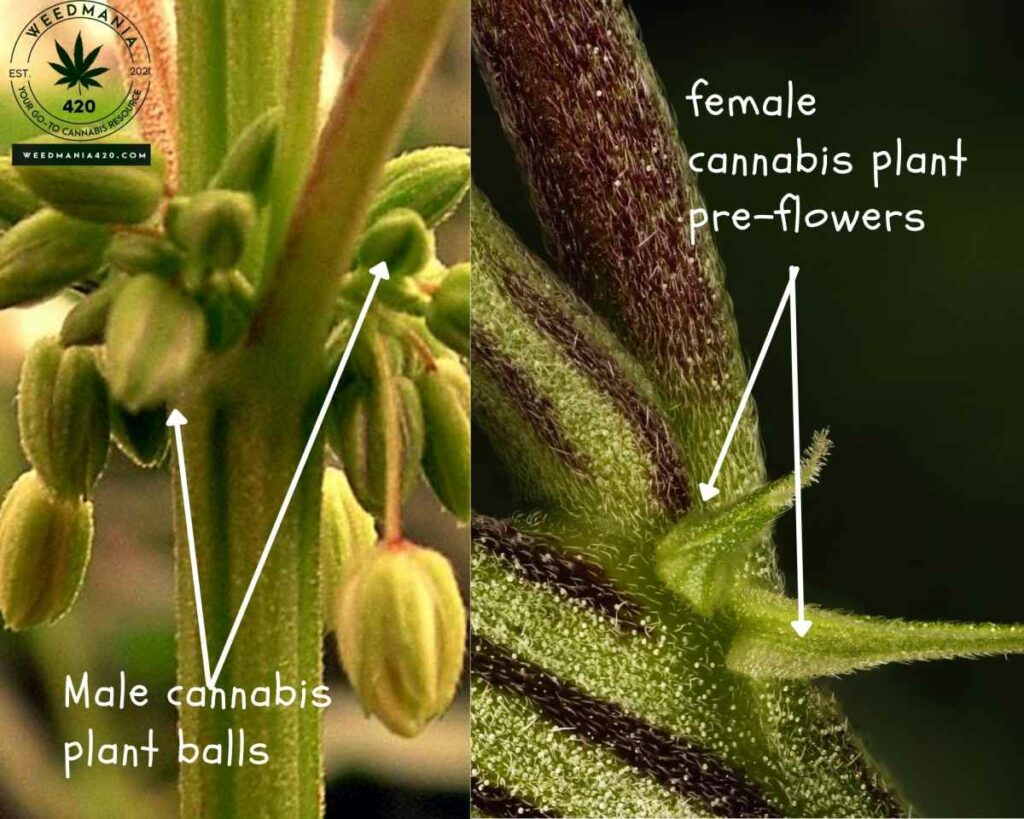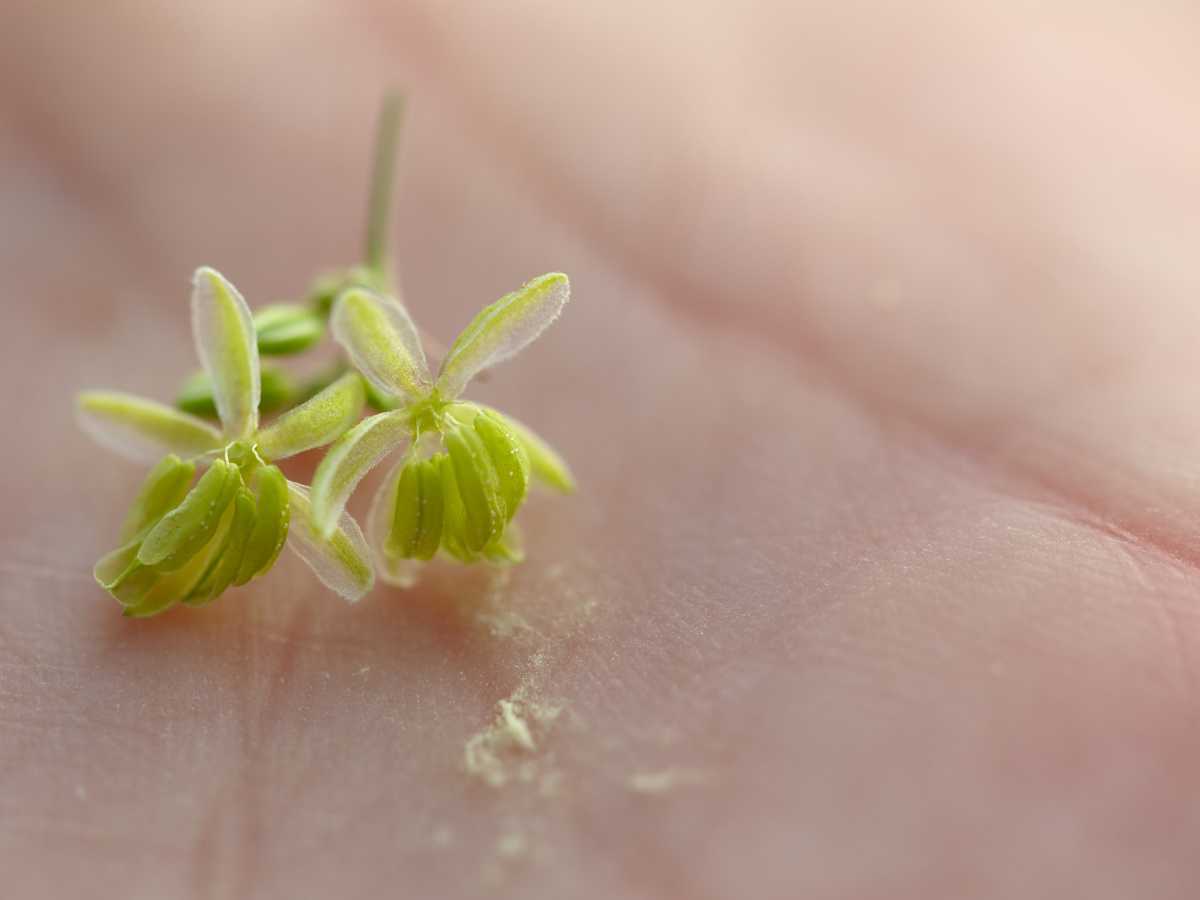The horror of losing your female plants to pollination can be nauseating. If you don’t keep a close eye to restrain the horny pollens from copulating with your females, forget about sinsemilla. Thus, it matters to know just how far away a male plant can pollinate female flowers.
A good grow should give you sinsemilla— seedless buds— these are more rewarding because the whole cola is useful. The trim is used for making hashish, rosin, and all manner of edibles.
And the buds are what every grower is toiling for.
If pollinated, your buds will be seed-filled and not as rewarding.
Having seeds grow from your buds reduces the yield and potency considerably because the plant channels all its resources to making the seeds.
Buds become the byproduct of the seed-production process— not the reason for the process!
And there wouldn’t be much.
Thus, you should surely keep the males away from females.
Verily, verily I say unto thee, if you’re not breeding weed, you have no business keeping the males.
Chop those boys fast before they grow balls and toss them. That’s what you should be doing with the males if you don’t breed.
It’s a Massacre!
How Far Away Can A Male Plant Pollinate A Female?
The male plants can pollinate female plants that are several miles away. The pollens travel impressively far and can reach your females even farther if they’re grown downwind from another cannabis farm. However, the viability of the pollen decreases with the distance it travels. Over 10 miles, the risk of pollination is negligible.
As a grower who’s only interested in producing the most potent buds, do not grow other males within a close distance— even if your females won’t be downwind from them.
The wind changes direction and thus allows male cannabis to spread their pollen in different directions around it.
If you thought the pollens could be swayed from their destiny by distance, surprise on you. The pollens might seem small and easy to toss aside, but they are adapted well for the task.
Cannabis is a dioecious plant, meaning the male and female flowers grow on different plants. It thus makes the plants interdependent for posterity’s sake.
The Lord makes no mistakes.
The pollens are adapted in several ways to foster pollination. But so are the stigmas of your female cannabis flowers. So let’s dig up some facts about this adaptation.

How Cannabis Sexual Organs Are Adapted To Foster Pollination
Both the male and female plants’ sexual organs are adapted in many ways to foster pollination. Cannabis is mostly pollinated by wind because bees aren’t attracted to cannabis flowers.
Here’s how the plants’ sexual organs are adapted to foster pollination;
The Male Plants Produce Massive Amounts of Pollen
The male cannabis plants produce a lot of pollen grains. According to Michigan State University, a single male flower can produce up to 350,000 pollen grains.
Considering each plant produces numerous flowers, that’s millions of pollen grain from a single male plant. So naturally, this increases the chance of pollen grains reaching your female flowers.
There’s nothing that a million pollen grains and more can never do!
Nature is full of by-ends. A moth feeds on a petal, in a moment the pollen caught on its breast will be wedding this blossom to another in the next county.
_George Iles
The Pollen Is Highly Protected
Pollen grains carry the plant’s promise to the future. It is thus given the protection of a generation-saving leader in ancient times.
The pollen comes covered in a hard layer that protects it from the ravages of the environment. It can land on the wrong surface, but it will still be alive and ready for the pollination task if the wind picks it up again.
The pollen is protected by a hard outer cover, which in itself is made of two layers.
The outer layer is hard as nails and is called exine. It is rich in sporopollenin, which is one of the most chemically stable biological polymers.
It protects the pollen from extremes of the environment like high temperatures, rain, or gusts of wind.
The inner layer of the outer covering is made up of cellulose, another tough-resistant organic material. It is called the intine. The double protective layer is important to the longevity of pollen grains.
The Pollen Is Structured To Stay Airborne For Long
Most insects stay away from cannabis flowers, and thus, the plant relies on the wind for pollination. It’s thus adapted for better wind navigation.
The outer covering enlarges the pollen grain, adding it more surface area for air resistance.
Thus, it can stay in the air for a longer time, making it easier for the wind to blow it even farther before it falls on the ground.
The exine also has folds and spikes that make it easy for the pollen to stick to the stigma. The stigma is itself feathery to help in trapping the pollen grains.
If distance allows it, the pollen grains have better chances of pollinating the flowers.
Why Are Buds Without Seeds Better?
Buds without seeds are more potent and yield better than the buds you get from pollinated flowers. Cannabis plant increases the number of their female sex organs in response to prolonged virginity. This improves the number of buds and size of the colas.
Thus, Sinsemilla buds are much potent, and the yield gets bigger the longer it goes unpollinated.
Cannabinoids are also more concentrated in female cannabis flowers than in males. However, pollination reduces the production of these essential oils by 56%, this 2016 study confirms.
Once the flowers are pollinated, you’re sure to get way less THC and CBD concentrations in your buds.
All growers try to keep their buds seedless because of the quality it delivers. As a result, they move off the shelves, unlike buds with seeds that you’ll struggle to sell at low prices.
The concept of increasing the potency and yield of weed by inhibiting pollination isn’t a new thing.
In the 1970s, growers were already removing male plants or planting only female seeds by either cloning or feminized seeds.
It’s a practice that has transcended growing cannabis for THC. Even hemp farms inhibit pollination when they need peak CBD production.
Those producing hemp for the grain used in food, feeds, and oil
are the only closest relative to cannabis growers who need pollination.
Those growing for fiber can do without pollination, but depending on clones and feminized hemp seeds is prohibitively expensive.
Therefore, some growers include a few male plants in their hemp farms so they can grow from seeds too.
How To Keep Female Cannabis Plants From Pollen
With the pollen adapted to remain airborne for miles, keeping your female flowers from the marauding pollens might seem a far-fetched dream.
Cases of cannabis pollen grains traveling from Morocco to Spain can kill your hope of ever harvesting sinsemilla, especially if you grow outdoors.
The risk of losing your plants to pollination is real, but it can be avoided.
Though pollen grains travel miles and miles, they become less viable with distance.
According to a study, pollen grains have a viability of 70% when released from anthers, but the viability rate drops to less than 5% in just 3 days.
Thus, by the time the pollen grains from another remote farm reach your females, they won’t be viable for fertilization.
Growing indoors also makes it impossible for foreign pollen to invade your female flowers.
All you have to do to keep away from pollen is to avoid growing the male plants in yourself.
Watch your seedlings through veg. Two weeks into flowering, you will spot any males and remove them before they mature enough to pollinate your females.
Tip: Avoid growing weed downwind from another cannabis field. Doing so leaves your female plants defenseless against wind-propelled pollens speeding towards them.
Here are early signs of a male plant to look out for;
Though you can only separate the female and male plants accurately during the first weeks of flowering, there are early signs you can spot even in veg.
The first being the cannabis plant’s growth structure. Male cannabis plants grow faster because they need to be taller when the females flower so that they can drop their pollens below to them.
Male plants also grow sturdier frames earlier to support their weight as they grow taller.
They also form spade-like pre-flowers at the stalk of the plant. Female plants will have thin and wispy preflowers. The preflowers are noticeable during veg, barely 6 weeks after germination.
Still, pre-flowers can be difficult to differentiate to novice growers, and waiting a little longer gives better results.
If you can’t figure these out during veg, you shouldn’t be worried. The first weeks of flowering come with more visible signs, and it’s still early enough to avoid pollination.
During the first two weeks of flowering, the spade-like preflowers of the male plants shall not be balls. This is about 8 weeks after germination for most strains, and your females won’t be pollinated because they still can’t pour out the pollens into the air.

I wrote an in-depth guide on sexing cannabis. It’ll help you determine the gender of your cannabis plants early enough to avoid pollination.
In conclusion, male marijuana pollens can pollinate females that are several miles away. Industry experts advise that males and females should be kept at least 10 miles away because the pollens travel extraordinarily far.
Still, the pollen grains weaken over distance. So the further they have to go, the lesser the chances they’ll still be viable for pollination when they land on your female flowers.
After 10 miles, the pollens will mostly be duds, which can’t pollinate.
Moreover, if you grow indoors, you’ll be having a physical barrier against which pollen grains can’t infiltrate.
The surest way to grow sinsemilla is to invest in feminized seeds; with them, you have a 100% chance of growing only females.
Also, keeping an eye on the preflowers is a surefire way to spot and destroy male cannabis plants before they turn your buds into a bag of seeded mess!

